We woke up Tuesday to strong winds, above the 25 knot wind limit set for Silver Bank whale watch operators. The weather delay meant a leisurely breakfast watching for whales around the mooring area. The coral heads scattered around us all had breaking waves washing over them, and some of the splashing off the irregular surfaces shot straight up. They really do look a bit like whales breaching or spouting in the distance, so we spotted lots of "breaching" reefs and a few actual whales as the morning progressed.
The inclement weather was not bad enough to stop the Dominican fishing fleet from going about their daily work. The video below includes a clip showing one approaching our boat, and you can see the two divers using the air compressor with long hookah rig hoses as a seat/leaning platform. A pile of pole spears and Hawaiian slings sits in the corner of the boat. As they depart, you can see the sun shining right through the thin fiberglass hull of the boat in places. In another shot, a skiff driver is bailing as he plows along through the waves, making it look a bit like the skiff is spouting sideways.

A game of Uno in the main salon occupied some of the guests, while others can be seen through the window as they read out by the bar. Not wanting to read or play games, I decided to wander around with my cameras and see what I found.
I wandered over to the galley door and caught Chef Jerry as he was preparing our lunch. Mmmm... Jerry's Mexican-themed creations were outstanding! Burritos, fajitas, bean and corn salad, guacamole and more!

Out on deck, I videotaped this Humpback and her calf breaching near the the mooring field, beyond the bow of the Turks and Caicos Explorer II.
Watching these huge animals launch themselves most of the way out of the water does not seem to get old. We were captivated every time, and even the experienced crew would always pause to watch a moment if a whale was breaching near the boats.
While I was at it, I took pictures and video of some coral heads "breaching" near the boat.
Beyond the reef line, you can see the white caps on large waves being stirred up out in the Atlantic Ocean. I could not believe it when I saw it, but some of the Dominican fishing skiffs actually ventured around to the outside of the reef to hunt that morning. They have a lot of faith in the seaworthiness of those little boats!
As lunch was being served, a group of whales were approaching the boat from astern. I decided to wait on the eating and stayed on deck with my video camera to film the whales as they passed by.
It was worth the wait, as they came by just off the side of the boat. You can see them in the video below, but I never put down the video camera to take any still shots.

After lunch, a storm band came through the anchorage, accompanied by some very strong wind gusts and a brief but heavy rainfall.
The storm line went away, and as the rain let up and I was able to get back outside some more whales came through the anchorage. We never had a shortage of whales, but sometimes conditions for watching them could have been better! Nature does not always cooperate, but that does make it more special when things go right!

This video shows the activity aboard the Sun Dancer II on Tuesday morning through the lunch hour and an early afternoon storm.

With the storm band and continuing wind preventing us from going out in the tenders to swim with whales, Oswaldo Vasquez and Amy Kennedy agreed to give a slideshow presentation to the group about their whale research work on the Silver Bank and elsewhere. They are trying to learn where the whales go, and when, to help prevent collisions with ships and entanglement with fishing gear, and with a view to establishing and expanding whale sanctuaries. Figuring out where they go is not that easy, and researchers use an array of techniques, including visual surveys from ships, aircraft, and from shore, photo identification, genetic analysis, bio-acoustic "fingerprinting" and using the satellite telemetry devices that Amy is here to deploy.
Here Oswaldo Vasquez, Advisor to the Minister for the Environment and Natural Resources of the Dominican Republic, is holding an arrow that has a hollow stainless tube with a foam rubber float wrapped around it where the point would ordinarily be. These arrows are fired from an ordinary crossbow. When they hit a whale, a small biopsy "plug" is captured by the tube. The foam rubber tip then expands, popping the arrow back out of the whale. It floats, so the researchers can easily retrieve it from the water immediately and preserve the sample. Oswaldo told us that the whales generally do not seem to feel the arrows at all, but they react to the boat. The biopsy samples obtained are useful in tracking whales through DNA analysis and in determining the diet and health of the whales and any contamination that may be in their tissues.
Researchers collaborate with each other, and with ordinary whale watchers, in assembling photo identification records of individual whales and dolphins. Oswaldo asked us to be sure to photograph Humpback Whale flukes at every opportunity, since every humpback has a unique pattern on the underside of the fluke. This long term tracking technique is literally "hit or miss" but has yielded important information about whale movements, their lifespans, mating habits and more. I did my part and got a few fluke photos of dubious scientific value along the way. I hope the people with better cameras did a better job. The waterproof Canon Powershot D10 I carry is perfect for me, but the shutter lag makes catching a fluke at the moment it is in the air difficult.
The Humpback Whale songs can also be used to identify whales and help to learn where they have been over time. We did not encounter any singers, but here is a great recording on the Conscious Breath Adventures website. All the whales in a given population sing the same song, and the song changes over time.
After Oswaldo wrapped up, NOAA National Marine Mammal Lab whale researcher Amy Kennedy got up to tell us about her work. I already put up a picture of Amy testing her harness on the introductory page, and here she is with the line throwing gun that they use to plant telemetry tags on whales. The gun is powered by compressed air from a SCUBA tank, and fires a small dart that sticks in the skin and blubber of the whale, leaving only the transmitter and a small antenna wire trailing on top. The satellite transponder units are made by Wildlife Computers, and are able to sense when they break the surface. They only transmit when they are on the surface, so that the satellite can receive the transmission.
Amy and her fellow researchers are trying to establish where the whales that visit Guadeloupe, the Silver Bank, and other parts of the Caribbean region come from, how long they stay, how individuals use the breeding grounds and what sex and maturity classes appear in different areas at different times of the year.

This slide shows the movements of Humpback Whales in the Caribbean that were tagged with satellite tracking devices during the 2008 season. The whales moved around the area quite a bit, from the eastern extreme of the Marine Mammal Sanctuary across the Silver Bank and all the way past Turks and Caicos, with one returning via the north coast of Haiti. This kind of information can help to guide area cruise ships around whale stocks and give regulators solid information to create speed limits in congested areas.
The Large Whale Project that Amy heads also tracks whales in other parts of the world, and she showed us this slide of the migratory paths taken by South Atlantic whales as they pass close to the coast of Brazil and then head to South Georgia and the South Sandwich Islands. She also had a slide showing the path of one whale that crossed the Bering Sea over a two week period in August 2010, then hung around near Russia for another couple of weeks before the satellite tracking device fell off.

Weather conditions improved during the presentations and we loaded aboard the tenders for an afternoon of whale encounters. At least, that was the plan. For once, the mooring area was completely devoid of whales, and we actually had to go look for a little while to find some. Eddy headed out to the deeper part of the bank downwind of the moorings, where we might find better visibility in the water. The chop had died down, but the water was still pretty stirred up.
After a while we came across a mother Humpback, her calf, and escort. They were moving slowly back toward the coral reefs, and we followed alongside some distance away for quite a while. They paused once or twice along the way, giving us hope that they would settle down to sleep, but then they moved off again.
While timing the breath cycles of the whales and watching for their reappearance on the surface, Captain Eddy would sometimes keep a coral head like this one between us and the whales. I guess the boat disturbs them less if it is beyond a big rock and coral formation.

When Eddy got particularly close to this coral formation, I again stuck my camera in to see if it could capture a reef scene from above. Not bad! Some blue wrasses of some kind, sea fans, brain corals and all kinds of old coral skeletons. It's hard to believe this is not the big attraction here!
The whales led us quite a ways upwind, and we wound up right back where we had started! Here the baby whale can be seen surfacing near the Turks and Caicos Explorer II. The whales then turned around and led us back downwind quite a ways, at which point the wind picked back up and they turned and started heading upwind again. A plot of our track around the area that day would look like a model of drunken indecision, but it was really all the whales' fault!

I kept trying to get useful shots when the whales would stick their flukes up to descend, but did not get close enough to get great detail. I doubt this picture is scientifically useful in identifying this particular whale, but maybe... We were perhaps a hundred yards away at the time, so I circled the fluke in the picture and enlarged it in the inset portion.
We were looking for whales up close to the barrier reef line toward the end of the day when Gene and Eddy told us about a clueless adventurer who had appeared earlier in the season. They noticed a cruising catamaran outside the reef line and thought it might be attempting to cross the reef. Captain Eddy called the boat on the radio and said, "You see that steel structure up ahead of you? You are about to make the same mistake he did! Turn NW and go around the reef!"
The boat continued to maneuver around outside the reef, and Gene said to Eddy, "They are about to do something stupid." Sure enough, the boat came right across the reef! They reported hitting it twice on the way, and Gene said the only reason the story did not end with a dramatic rescue attempt was that they did it on a high tide in a shallow draft boat. The cruisers reported that their chartplotter, set on 100 mile range, did not show the Silver Bank reef, and they were distracted by setting up the BBQ before sunset. I really don't know where to start with this story, so I'll just let it speak for itself.
We eventually made our way back to the Sun Dancer II without getting in the water with any whales that day. We had fun anyway, saw lots of whales, and enjoyed learning about them from Oswaldo and Amy. That is all you get to do when watching whales in most parts of the world, so being in a place where not getting to actually swim with them is something of an irregular disappointment is pretty special. Gene looks a bit wind-whipped and disappointed in this shot as we approach the Sun Dancer II, with Scooby standing by to receive our bow line.
Because waves can be pretty large in the mooring area and the ship can swing quite a bit at anchor, the standard procedure for bringing the tenders alongside is to toss out a heavy bow line, which is then secured to the ship, then reverse hard with both engines, backing the stern of the tender around to the stern of the ship. By the time the two are close enough to hit each other, the big, orange ball fenders are in between to protect them. It's a good time to remain seated until the captain has turned off the "fasten seat belts" sign. They told us that moving from the tender to the ship would be the most dangerous thing we would do all week, and I think that is true. Timing your step to the motion of the boats is crucial.

After we got our gear rinsed and got showered and dried off, we went up to the Lido Deck for the daily Sundowner Party. Looking over the aft rail, I saw some Dominican fishermen approaching in their skiff. These are friends of Scooby's, and they stopped by the boat a few times while we were out on the Bank. I think he might be negotiating for fish for our dinner or something. I was pretty impressed with the pile of lobster to one side of the boat and the pile of conch on the other side. Those are some big lobsters! I think the barracuda on top of the lobster pile was destined to be their dinner.
Thanks to Elliot Davidson for sharing this picture of the sunset on Tuesday, showing the spectacular gold sky and black water of the Silver Bank.
As we watched the sun go down, I could tell I was causing great pain in Oswaldo's heart by mixing really fine sipping rum with Coca Cola, so I decided to try drinking some his way: on ice. I had never really enjoyed rum like that before, possibly because I never really gave it a chance, but it was really good! We went inside at dark and had a rich dinner with pork chops, then stayed up chatting with Gene for a while about his plans for the future.
I guess all of it was a bit too much for me, and I woke up nauseated at about 1:30 am, so I did not have a great night's sleep, but I felt OK by morning.

Fourth Day on the Silver Bank
Swimming with the Humpback Whales
As we were getting coffee at sunrise, Elliot and I were alerted by Barbara and Carlos to some whales resting beside the boat. "Logging" was how another of the crew described it, and one was floating on the surface very much like a log. It can be seen in the video below.
Out looking for whales, we came across this Humpback calf breaching energetically. It was really getting into the joy of flight, as you can see in this picture.

The wind continued to blow up to 20 knots Wednesday morning, making conditions a bit difficult for swimming with the whales. The plume of mist that the whales make when they spout dissipates quickly in strong winds, making it hard to find whales in the first place. Once whales are found, the surface chop and wind affect the boats and divers, making it difficult to remain in one place. Last but not least, the several days of wind had stirred up the water quite a bit, and visibility was poor.
I took the picture at right of waves breaking over the large coral patch while we were waiting for Gene to call us into the water. He swam over to whales several times, but each time that we tried to get near them with him in the water, they moved off. Gene explained that whales, like humans, have a certain personal comfort zone, and do not appreciate intrusion. When divers slowly drift into the zone in good visibility, the whale monitors the intrusion and may accept it. When a group of us appears out of the blue already within the comfort zone, the whales move off.
In this picture of a small coral patch reef, you can see the tip of Sonja's fin. We were once again awaiting the signal to go in the water when I took the picture. In the background, you can see the Turks and Caicos Aggressor II on her mooring. Small patches of coral like this one are the reason several of the crew on these boats keep a sharp lookout when approaching the mooring area. They are everywhere, and while they are pretty easy to spot, they can do a lot of damage if you fail to notice one.

I never got tired of trying to photograph the reefs by sticking my arm over the side of the boat! In this one, you can see a bit of bleaching on the tips of some coral branches. Some of the giant coral heads show extensive damage from deliberate bleaching by fishermen. It's hard to believe anyone thought this was a good idea, but one way to get lobsters, fish, and everything else to come out from all the holes and crevices in a reef patch is to inject the whole thing with a bunch of chlorine bleach. Of course, it kills most of the coral when they do that. The method is no longer used, but coral grows slowly, so the damage remains.
We saw a Humpback calf playing on the surface off the bow of the Aggressor and headed over that way to see if the mother was sleeping and would be receptive to divers.
The whales were moving around slowly, not seeming to head anywhere in particular, but we were still frustrated in our attempts to get in the water with them. Several times Gene got in the water, only to get back out when they moved a short distance away again. When we did get in the water, we generally did not get close enough to get a good look before they moved. Again, the low visibility was causing us to suddenly appear too close to the whales. They were not alarmed enough to bolt, but just slowly moved away.

After a while, the whale pair we had been watching started to move along steadily, and we decided to try a "fly by" in the water. The whole group of us dropped off the boat near the path of the approaching whales to see if they would pass by near us. They did! In this picture, you can see a bit of my wife, Sonja, and the mother and calf Humpbacks beyond. The mother is on the surface, the calf below. As you can see, we were within the mom's body length of both whales, and still barely able to see them.
In this picture, taken as mother and calf passed in front of and below the group of swimmers, the calf came out nicely, but mom is barely visible. Her mouth and the tubercles and barnacles around her chin can be seen in the lower left corner, and her body actually occupies the entire bottom part of the frame.

The calf approached us near the surface in the picture at right, and I could see why Gene has that fisheye lens on his underwater camera housing. Whales are large subjects, and I was barely able to get part of the calf in this frame while getting a small piece of his mother. She came out looking like a film developing mistake, so I cropped to get only the calf.
The two pictures at left were taken using the continuous shooting mode on my camera. In the first one, mom and calf are just lazing along, having passed by the group of divers. In the second frame, you can see the turbulence created by the calf as it darted down in front of its mother. That was the end of that encounter, since even the mother's slow cruising speed was far too fast for humans to follow.

As the whales departed the area, Elliot decided to have a little fun while waiting for the tender to come and pick us up. He dove down a few feet and started swimming with his fins together, imitating the motion of the whales. It looks funny when a human does it!
At some point during the whale swimming fun, I got a pretty bad cramp in one calf, making the muscle sore, and I also managed to wrench my shoulder a bit climbing back into the tender from the water. I was feeling a bit beat up after all that, and a cheeseburger for lunch knocked me right out.
I missed out on an opportunity to go along on the whale tagging mission during lunch with Amy and Oswaldo. In the picture at left, Terence is securing the bow line, Amy is already looking for whales, and Oswaldo and Sonja are in the back of the boat near Gene, who is driving. Also slept right on through the afternoon whale watching, which I was told went about like the morning session: limited success due to poor visibility.

I was feeling better when I woke up, and enjoyed a relaxing afternoon sorting through my photos and videos in the salon before the whale watchers returned. Once the boats got back, we had the afternoon Sundowner Party, and Sonja and I were both feeling quite jolly. Thanks to Elliot for this photo!
Another spectacular Carribean sunset, but no green flash this night either. We all went inside for a delicious dinner of pork ribs, after which Gene did a slideshow presentation on environmental issues impacting the oceans and whales.
See the video below of our activities on Tuesday and Wednesday.

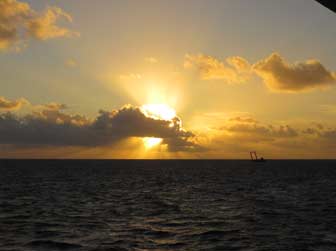
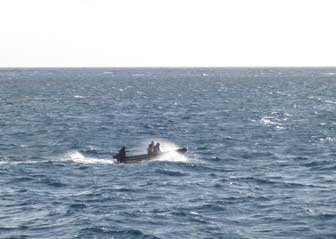
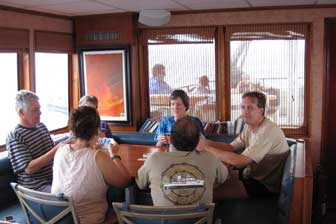
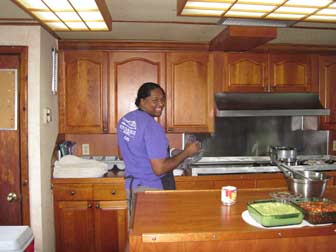
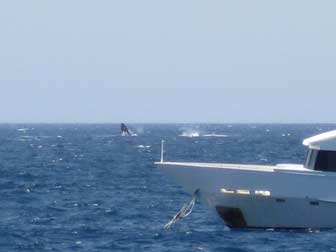
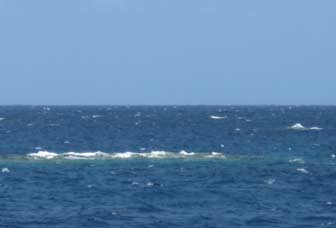
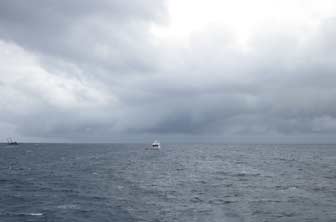
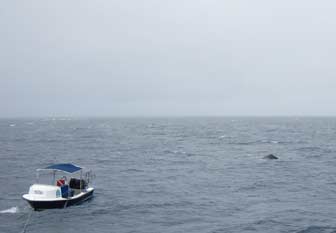
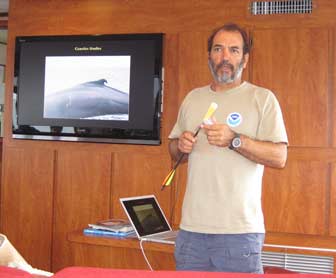
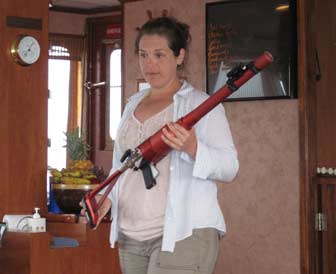
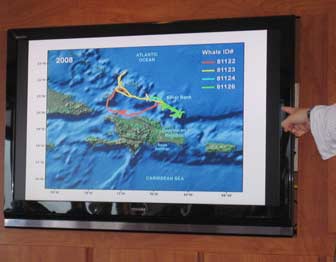
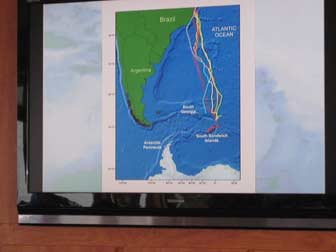
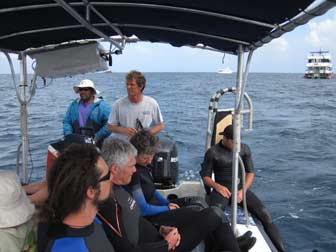
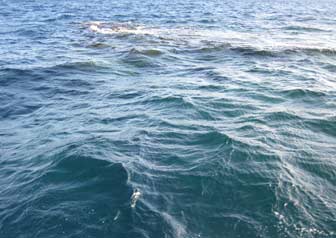
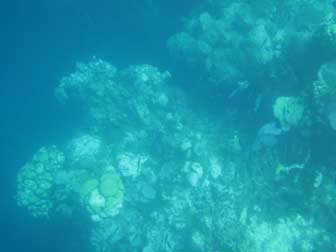
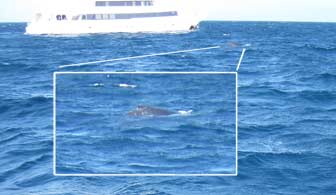
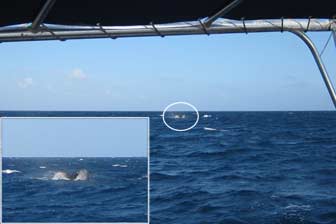
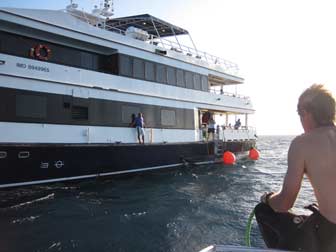
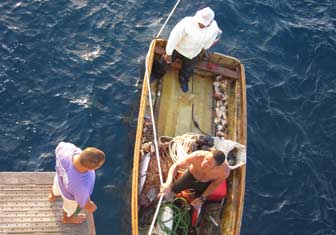
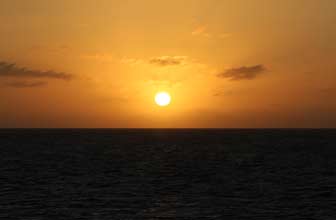
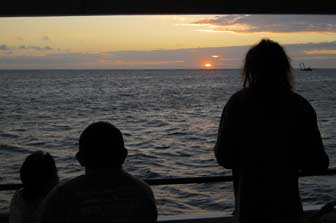
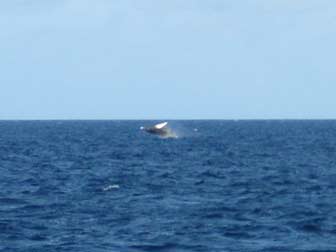
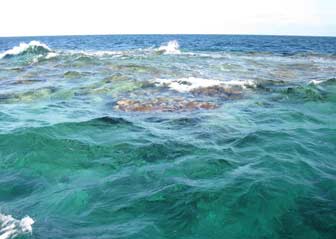
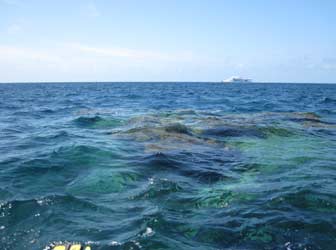
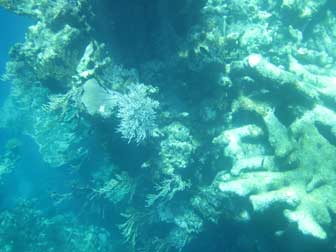
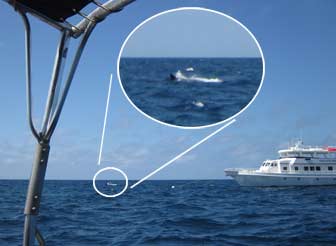
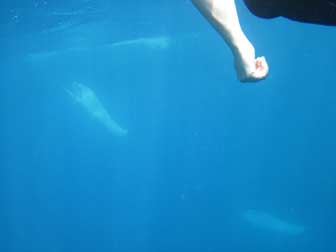
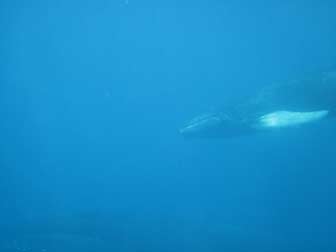
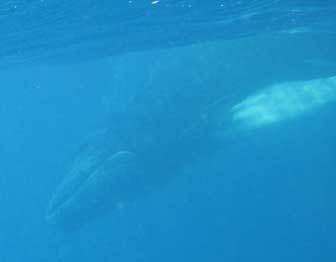
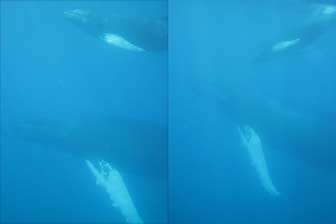
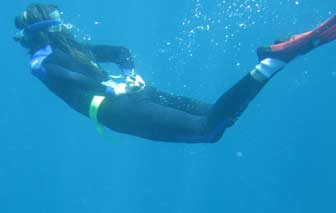
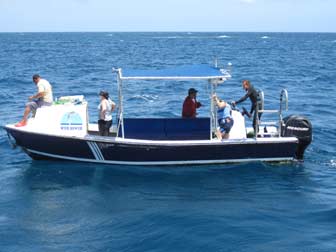
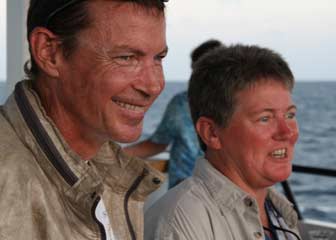
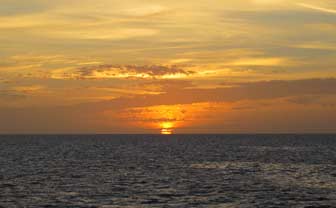
Leave a Reply
You must be logged in to post a comment.